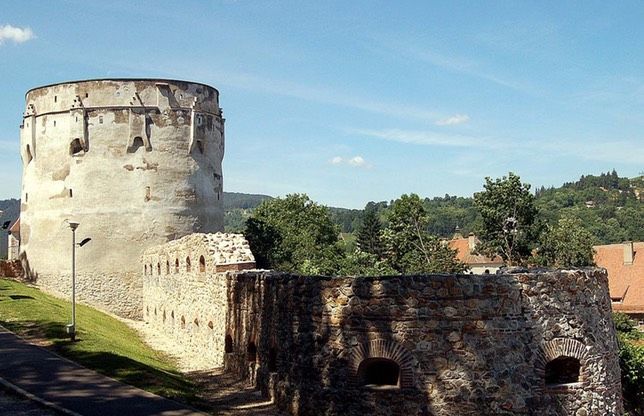In the Middle Ages, the walked city of Brașov was one of the most important fortress in Transilvania, destined to defend the province against the attackers coming from the south. The construction of the defensive wall was begun in the 14th century and completed in the 17th century, when the 12 m high and 2 m thick walls stretched for about 3 km.
From the fortifications system (walls, bastions, tower and gates) are still preserved: the wall on the northern side (the Graft canal), the Black-smith’s Bastion, the Butcher’s Tower, the Gate Bastion, the Ecaterina Gate, the Weaver’s Bastion, the Rooper’s Bastion, the Draper’s Bastion. As for the defense fortifications situated outside the walls, still visible are the watch-towers – the White tower (15th century), situated 30 m above the town level, and the Black Tower (14th century), which stand above the Blacksmith’s Bastion, erected on a rock near the NW side, housing at present the State Archives; the Citadel, sited on the Citadel Hill, can also be seen.
The construction of the Citadel was begun 1553-1554 by the Austrians. It was maintained for military purposes until the middle of the 19th century. In 1623 was mentioned the existence of well 81 m deep, within the Citadel. The outside citadel was erected 1625-1630, having the four bastions at the corners of the fortified quadrilateral. In May 1688, the Citadel was the headquarters of the Brașov insurgents against the Austrian Royal Army’s taking hold of the city. The last military action took place in June 1849, when the Russian troops bombed the Citadel, which was defended by Hungarian revolutionary troops.
The Graft canal was excavated in the 14th century at the foot of the Warthe Hill, as a natural obstacle against sudden attacks. On its edge the first defensive wall of Brașov was built, reinforced with two strong bastions at each end (The Blacksmith’s Bastion and the Leather cutter’s Bastion). Near the White Tower stands the Graft Bastion, built in the latter half of the 14th century, perpendicular to the NW wall of the Citadel, acting as a bridge over the canal, by means of which the food and water supplies were brought within the city walls. The Graft Bastion was restored and became a museum in 2003-2004, fitted with a staircase that leads to the White Tower. At present, the area known as “Dupa Ziduri” (Behind the Walls) is an attractive place for those willing to take romantic walks alongside the alleys dominated by emblematical buildings, reminiscent of medieval Brașov.
Ambient Team is waiting for you with many surprises and our staff is always at your disposal. You’re welcome to come!

